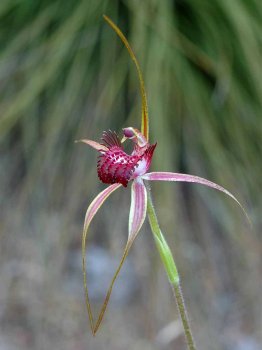
The WA Herbarium has named seventeen new spider orchids, from north of Geraldton to east of Esperance.
Kevin Thiele, the curator of the Herbarium, told the ABC that finding and naming plants is always exciting and fulfilling. Some of the rarest were discovered near Busselton.
The spider orchid genus Caladenia is one of the most varied of the WA orchids, Thiele told ABC's 'South West Mornings'. "Some of them are very spidery. Some are really weird. Some have shorter petals and various colours. Some of them actually look like insects.
"The classic spider orchids have long filamentous petals, 10 cm or more long and are often coloured white or pink. One of the five spreading petals usually curls over the top. If you look closely, they have a special petal called the labellum in the centre of the flower, which has extraordinary clubs and protrusions."
The labellum is part of the pollination mechanism of the flowers, he said.
The Herbarium's role is to understand, document and name WA plants. Recently, they passed the 10,000 species mark and hold around 750,000 specimens.
Around fiftynew species of plants are added in WA every year. Of the recent finds, eleven were new species and the other sub-species. One of those found around Busselton is Caladenia swartsiorum, a very rare orchid only known around the Harvey Estuary and Lake Preston.
"It's one of the examples where naming, discovering and figuring out these orchids is really important because once we know about them, we can ensure their conservation," Thiele said.
The South West is a globally recognised biodiversity hotspot, he notes. That means that the area is rich in wildflowers but also contains a high threat. "This new species is a good example”, Thiele said. “It's important but it is extremely rare. It's restricted to only a few remnant patches of bushland and conservation from threats [like] weeds is really important."
Andrew Brown of the Department of Parks and Wildlife and Herbarium research associate Gary Brockman, wrote the research findings paper, Thiele said. "It's also important to remember that taxonomy, the naming of species, is a science. The paper has been published. Over time, people may go out and find other populations, which start to blur the boundaries a bit.
"We will make decisions over the years to come. Many of the really obvious species have been named, so to some extent we're getting down to species that are either rare or difficult to figure out.
"With spider orchids, the differences are sometimes fairly subtle." Even the expert botanists can struggle with the new taxa, Thiele said. However, he added, many of these discoveries are clearly new species. "They are obvious to anybody."
Source: abc.net.au



 Classifieds
Classifieds

